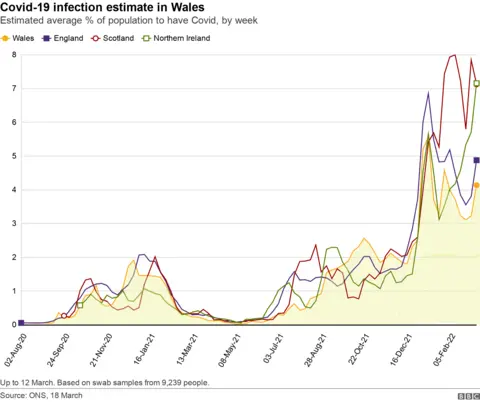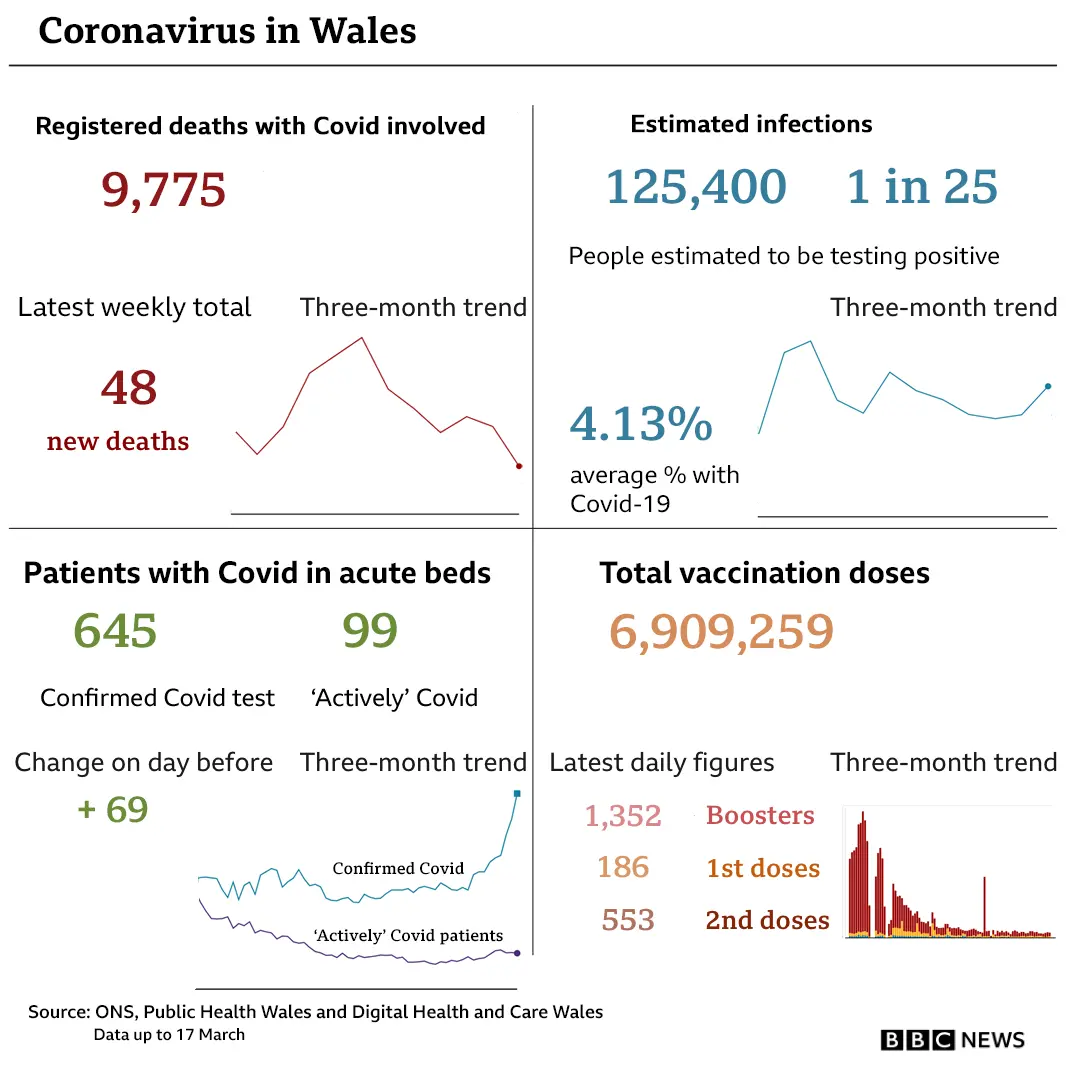Covid pandemic: Infections continue to rise in Wales
 Getty Images
Getty ImagesCovid-19 infections are continuing to increase in Wales, one of the key indicators of the pandemic has shown.
One in 25 people are estimated to have had Covid in the latest week, the Office for National Statistics (ONS) said.
Its weekly swab survey, which has been ongoing since 2020, takes thousands of samples from households each week.
About 125,400 people had the virus in the week ending 12 March, which is 4.13% of the population.
That is an increase on the previous week's estimate, which was that 97,900 people were infected.

Cases linked to pupils and staff in schools in Wales have shown a drop in recent weeks but there has been a rise across north Wales, with 162 infections recorded by Public Health Wales in the last week.
Ysgol Friars in Bangor, Gwynedd, has seen a recent spike in cases, with headteacher Neil Foden saying numbers had reached a "peak we haven't seen since the height of the pandemic".
Mr Foden said parents had been sent a letter after the school had 34 confirmed cases on Monday.
"We've been averaging up to 10 a day so we're up to 70 by the end of the week," he said.

The swab survey has become a reliable and increasingly important tool to measure the level of infections, as testing data becomes harder to read.
The age group in Wales with the highest proportion with Covid was estimated to be two-year-olds, as well as 26 and 27-year-olds (8.3%) but to be as low as 0.7% in those over 85.
ONS said the percentage of people testing positive increased in adults aged 20 years and over but the trend was uncertain for younger ages.


The estimate for Wales is a lower proportion than those for the other UK nations and all but three English regions - north east England, Yorkshire and Humber and West Midlands.
Infections are estimated to involve one in 20 people in England and one in 14 in both Scotland and Northern Ireland.
The infection survey is a useful indicator, as it is not only carried out among thousands of households weekly but picks up asymptomatic people.
With the winding down of mass testing in April, it is expected to become the most reliable surveillance tool.
Separate figures from Public Health Wales are also showing the fast spread of the sub-variant of Omicron - although the indicators are that it is not leading to more serious illness which requires hospital care.
There were twice as many cases involving the sub-variant of Omicron (BA.2) sequenced in the last week compared to the main Omicron variant (BA.1).

It is dominant in most areas of Wales, apart from Anglesey and Gwynedd.
With remaining Covid restrictions set to end across Wales on 28 March under Welsh government plans, including face mask laws, people in Bangor were keen to see rules fully lifted.
However some urged caution given the rise in cases.
Adam Kennedy, from Beaumaris, Anglesey, said: "It's all easing everywhere isn't it? We're slowly getting back to normal."

Student Alys Hughes, from Caerphilly, said: "I think it'll be OK as long as it doesn't creep back up to the worst of the worst. I feel like we're prepared now and ready now."
What do the other figures tell us?
Numbers of hospital patients testing positively for Covid are continuing to rise - and are up by a third on a week ago.
But on Wednesday, 85% of these patients were in hospital to be treated for something else.

- Public Health Wales figures show the case rate has risen over the last 13 days to 304.4 cases per 100,000, a 50% increase in a week.
- When lateral flow test positive data is taken into account, this would mean a rough estimate of cases rising 68% in the last week.
- But the numbers of the most seriously ill patients with Covid remains roughly the same as it has for the last two weeks. Only seven out of 12 patients in critical care with Covid on Wednesday were being actively treated for the virus.
- As well as patients testing positive for Covid when admitted for other conditions - there were 264 patients across Wales who caught Covid while in hospital in the most recent week.
- There was a rolling average of 633 hospital patients with confirmed Covid on 17 March, a rise of 33% on a week ago.
- But only 99 (15%) of confirmed Covid patients in acute beds on 17 March were being primarily treated for the virus, with 546 in hospital to be treated for other conditions.
- The average daily number of patients on critical care or on invasive ventilation is 11 - about the same as a week ago (10) and around a third of the number we saw in early January.
- Cwm Taf Morgannwg health board has not had a critically ill Covid patient for two weeks and Aneurin Bevan has had none for nine days.
